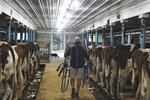
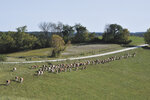
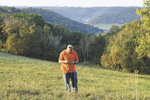

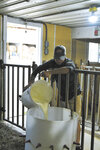
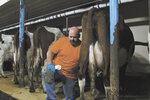
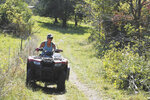

LA CRESCENT, Minn. — On Oct. 3, the barn door at Enchanted Meadows Farm framed the dawn as it transitioned from darkness to purple and pink, and then to morning sunshine that revealed the farm’s pastured terrain.
Inside the 56-stall tiestall barn, Chad and Melissa Crowley milked the herd of 97 organic Ayrshire cows.
Morning began at 5 a.m. with the Crowleys sending the cows from the pasture to the barn.
Milkers were going on at 5:30 a.m. Assisting the Crowleys for the first hour was Art Thicke. The Crowleys are part owners and the next, non-family generation on Art and Jean Thicke’s farm. The Crowleys, while being the next managers, are partners with Art on day-to-day work and decisions. That morning Art had to leave early for a golf outing.
“We like to see Art be able to farm as long as he can,” Melissa said. “He still enjoys coming out.”
During milkings Chad and Melissa visit about their family, farm, to-dos and goals. Melissa said milking allows her to “talk his ear off.”
Chad appreciates that they milk together. For a lot of farm couples, Chad said unfortunately one of the two must get an off-farm job.
“We don’t have to do that,” Chad said. “We get to share in the enjoyments of farming together and the trials and tribulations and everything else that goes with it, and because of that, we can understand each other.”
Around 6:20 a.m. the Crowleys brought the second half of the cows into the tie stalls for milking.
The Crowley’s herd is fed eight pounds of grain each day along with unlimited first-cutting hay when they are in the yard. Through the day, they are pastured.
One-hundred twenty acres of pasture are divided into 48 paddocks for the cows that produce about 1 million pounds of milk, Chad said.
“No matter if we have 110 cows, or if we have 85, that’s what the farm puts out,” he said.
Melissa said they are not production minded.
“We’re sustainable minded and longevity (minded), taking care of the land and taking care of the animals,” Melissa said.
The Crowleys have had a cow last 16 lactations. Chad said the average age of cows in their herd is 5-8 lactations.
“If a cow only makes three lactations in our system, that is not what we’re looking for,” Chad said. “We’re looking for cows that’ll make 10 years. That’s where we profit.”
Around 7:15 a.m. the last milkers were coming off. Melissa started getting the milkers washed and feeding the last two calves of the season while Chad finished milking and sent the cows out.
Calves are fed unpasteurized whole milk mixed with warm water in small groups of up to six on barrel feeders.
The Crowleys have a closed, line-bred herd. They calve seasonally, with 70% of calvings occurring during March-April. The other calving season is from mid-August through September.
They use an outside beef bull for clean-up for the spring calving season and all fall calves. Beef calves are sold. They calve in 24-26 dairy heifers a year.
After Chad scraped the barn and fed grain to this spring’s crop of future herd bulls, he was ready before 8 a.m. to give the cows fresh pasture.
The cows had walked out and were waiting. They receive fresh pasture twice daily.
Crowley divided a new section using poly-wire. The Crowley’s pastures are on bluff land with views of miles of nearly untouched terrain.
“We enjoy calling this home,” Chad said.
The Crowleys use wait times of 50-70 days between grazing. Last year, they grazed until December.
“Even in drought years, we’ve never run out of grass,” Chad said. “We’re able to maximize the entire farm and stay profitable.”
The Crowleys manage their pastures by clipping. They also hand dig thistles out of fence lines.
By 8:30 a.m. all chores were done except Melissa’s graining of the spring calves and letting them out to pasture.
After chores, Chad and Melissa took a break to eat breakfast, relax, work on inside tasks and get ready for their afternoon project.
Around noon, the Crowleys started preparing a pasture lane for winter. They cleaned out trees, brush and an old barbed wire fence. Once cleared, they plan to bring in loads of lime to keep the lane from becoming muddy.
Chad operated a chainsaw. Melissa dissembled the barbed wire and they both hauled the brush.
“We joke, ‘Why do the trees always fall into the pasture? Why can’t they fall into the woods?’” Melissa said. “We are always maintaining different fence line areas.”
At 2:45 p.m. Melissa brought in the spring calves, gave them grain and locked them in for the evening. The Crowleys balance the calves’ ration by controlling the amount of grass, hay and grain they receive. The calves are also still in the process of being trained on pasture.
Then, Melissa took a water truck to the heifers to fill their stock tanks.
Around 3:30 p.m. Chad started the cows walking back to the barn and went to prepare their evening pasture.
The Crowleys have trained their cows to follow them and come at their call. Once started in the right direction, the cows will take themselves home.
In the late afternoon, a calf buyer came for two beef calves.
At the barn, milkers were on at 4:30 p.m. At 7 p.m. the Crowleys were wrapping up milking and doing cleanup. They finished their day with relaxation and bowls of chili with cornbread.
Comments
No comments on this item Please log in to comment by clicking here